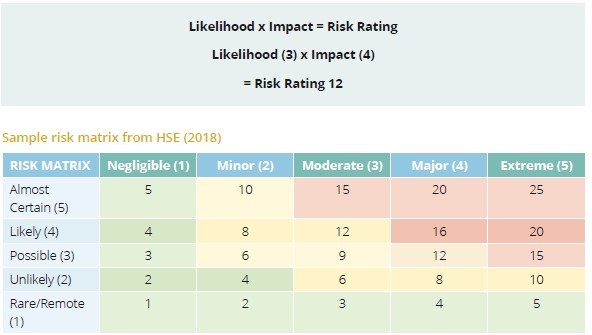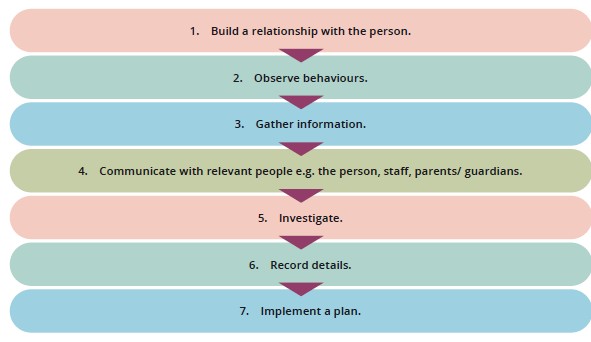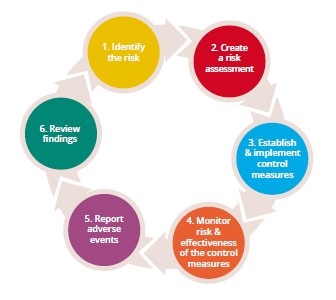Chapter 52 – Grace O’Flynn (D3SOP12)
Domain 3 Standard of Proficiency 12
Be able to carry out and document a risk analysis and implement effective risk management controls and strategies; be able to clearly communicate any identified risk, adverse events or near misses in line with current legislation/guidelines.
|
KEY TERMS Risk analysis Effective risk management Communication Positive risk-taking Staff-associated risks
|
Social care is … managing risk to ensure that we can support the people in our care to exercise choice, engage in activities and live a full life. |
Tip
Remember: Risks can have both positive and negative outcomes. Exposure to certain risks can give people the opportunity to grow and develop.
Risk analysis
Risk analysis is a process of identifying risk or potential hazards (HIQA 2014: 7). A hazard is something that could cause harm to someone. Risk refers to the likelihood of this happening (HSA online).
When assessing risk, it is important to ask:
- What is the hazard/hazardous activity?
- Who is at risk?
- Why are they at risk?
- Where are they at risk? (In specific environments?)
- When are they at risk? (At particular times, e.g., at night?)
The person identifying and assessing the risk is called the assessor. In social care, risks are measured using a scale. This scale is usually calculated by assessing the likelihood of the risk occurring, multiplied by the impact of harm caused by the risk. The HSE risk matrix (2018) enables the social care worker to objectively review the risk, helping them and the team to support the service user to make a safe decision.

To successfully identify a risk and complete a risk analysis there are steps a social care worker should take.

Risk assessments should be unique to the individual. A person-centred approach should be taken. A risk assessment may be necessary for one person you support, but not another.
Remember: Not every activity must be risk-assessed.
Effective Risk Management
Managing risk can be a challenge for social care workers. It is a key aspect of our work as it enables us to provide safe and effective care to those we support (HIQA 2014: 4). It is important to acknowledge that not all risks can be eliminated. Despite some of our best efforts, there are always levels of risk associated with certain activities. It is our role to establish the best way to minimise or reduce this risk while supporting the person to carry out the activity. If minimising the risk is not possible, we may look at ways to educate the person we are supporting about the risk and make them more aware of the level of harm associated with the activity.
There are two approaches to risk management; preventive and reactive. Social care workers may aim to take a proactive and preventive approach by putting supports in place before the activity or action occurs (HIQA 2014: 4). For example, if a person you are supporting has decided to take up a new hobby or start a new job, you may look at the risks associated with this action. If there are evident risks, it is your role to put adequate supports in place to minimise this risk. This is a preventive measure. Before the person begins doing the activity, you have clearly identified the hazards and provided additional measures to reduce the level or likelihood of harm.
PREVENTIVE = BEFORE
In contrast, reactive risk management refers to a response to an adverse event or incident that has occurred (HIQA 2014: 4). If an accident or incident arose, it is your role to review why and how this happened. It may be apparent that there is a level of risk associated with an activity that you were unaware of. On reflection and analysis of the event, it may be possible to identify the areas of support required to reduce the likelihood of the risk recurring. Alternatively, a response may be to put supports in place to reduce the impact of the risk. For example, a person you are supporting falls off their bike and bangs their head. On investigating and analysing why the event occurred, you may become aware that the individual removes their helmet as soon as they turn the corner away from the service. In order to manage this risk effectively and to support the person to carry out the activity safely, you may look at control measures that can be utilised for the future. This might look at educating the person on the benefits of wearing a helmet when cycling and the possible consequences of not wearing it. These measures are implemented in response to the incident (after); therefore it is termed reactive risk management.
REACTIVE = AFTER
A key aspect of risk management is involving the individual you are supporting in the process. Remember in disability services, you cannot stop someone doing an activity just because there are risks associated with it. It is their choice. You must weigh up the positives and negatives associated with the risk. As a social care worker, you have a duty of care to keep people you support safe. However, this must not impact on their human rights. They have a choice to make poor choices, or decisions that you may not agree with or see as ‘in their best interest’. People make choices every day that others may deem as poor, but this is ultimately their choice. Your duty of care lies with educating the person about the harm associated with an activity and supporting them to look at alternative or safer ways to engage in it; but you should not infringe on their human rights.
Tip
Refer to HIQA’s Guidance on a Human Rights-based Approach in Health and Social Care Services.
Communication
Communication is a key aspect of risk management. It is essential for identifying what hazards and harm can be caused to a person. By communicating with the individual themselves, and with other relevant parties, risks can be identified and acknowledged. Communication is used for establishing ways in which the risk can be managed. It supports creative thinking, perhaps by brainstorming about the supports that can be put in place to reduce the risk, and creates continuity of care. Plans for intervention communicated effectively to the individual and staff team allow for smooth application in practice and can lead to better outcomes. Communication supports continuous learning and growth as we reflect on where things may have gone wrong when adverse events occur or areas of support that worked well.
One example of communication is how to document the risk you are assessing or monitoring or the incident you have witnessed.
Documenting risk assessments
Written communication is essential for effective management of risks. Having successfully identified hazards and likelihood of harm, a social care worker must document their findings. Always refer to your organisation’s policy on risk management for guidance. By noting why an activity is hazardous, when, where and who could be affected, you are providing knowledge to others involved in the person’s care. Setting out the agreed control measures and supports shows how the risk will be managed. This process demonstrates action and the response to the duty of care we have for people we support. Inserting the risk rating highlights the priority of the risk. The risk assessment document as a whole shows the rationale for identifying the risk and provides context to the intervention or supports that are required for managing it. Clear recording of the risk and control measures provide all relevant parties with the information they require to support a person to do an activity safely. It also communicates how the person themselves likes to be supported to engage in this activity.
Recording accidents and incidents
Adverse events or near misses can happen when learning and developing ways to manage risks. Despite putting interventions and supports in place, sometimes harm can be caused to a person. This may be due to circumstances that are out of our control. Often it is not possible to highlight every hazard and eventuality and implement effective control measures. In line with current legislation and guidelines, you are required to compile a report of accidents, incidents and near misses and may be obliged to report them to the inspectorate of your service (e.g. HIQA/Tusla) within a specific timeframe (HIQA 2014: 10). Recording these events are critical for reflection and growth. Social care workers should record adverse events factually and objectively. Providing the facts and details that resulted in the harm caused to the person enables us to review, reflect and rethink our approach. There may be a clear reason why the risk caused harm and there may be a simple solution. Not correctly documenting the details of the event hinders our ability to analyse the risk and reduce it for the future.
Reviewing and monitoring risks
This is another integral part of effective risk management. It is important to review accident and incidents reports regularly to determine whether the control measures are effective. If the risk is occurring regularly, further investigation and additional control measures may be required. The intervention in place may not be sufficient. By regularly reviewing the risks assessments, social care workers aim to adapt the approach to suit the needs of the individual. There may be a change in circumstance which has led to an increase in the likelihood or impact of harm associated with the risk. Risk assessments should be reviewed in line with legislation and organisational policies.
Risk register
In addition to recording adverse events and documenting individual risk assessments, services often use a risk register. This is a list of all the identified risks associated with that service. They may include a record of all the risks identified with the people we support and staff- or service-associated risks of working in that environment. The register will often rank the risks from high to low, placing the priority on those that have the highest risk rating. Colour coding is often used to indicate the priority, for example a traffic light system of red = high risk rating, orange = medium risk rating and green= low risk rating.
Recap

Mark
Mark is a 30-year-old man with an acquired brain injury. He lives in an assisted living service in Dundrum. Mark really enjoys going out with his friends to the cinema on Friday nights. They go to the Savoy on O’Connell Street. As a result of his brain injury, Mark has short-term memory difficulties and requires a rollator to mobilise but is very reluctant to use it. When accessing public transport independently, Mark can forget which bus stop to get off at and can become disoriented. Mark has a history of ending up in unfamiliar places and has difficulty navigating his way back home. Mark is a film fanatic and organises his week around catching up with friends and seeing the latest film release. Marks’ parents dislike him travelling independently due to the possibility that he may get lost.
As a social care worker, your role is to support Mark to do this activity safely. In order to successfully support Mark, you must establish:
|
1. What is the risk? |
Getting lost while travelling independently |
|
2. Who is at risk? |
Mark |
|
3. Why is Mark at risk? |
His short-term memory loss and becoming disorientated |
|
4. Where and when is he at risk? |
When getting the bus to and from the cinema on Friday nights |
After building a relationship with Mark and understanding the importance of this activity to him, social care workers must identify the areas of support that are required. The social care worker should chat to Mark about going to town weekly, acknowledge the meaningful relationships he has with his friends, and the enjoyment he gets from the activity. They could discuss the concerns that have arisen during past trips and ask if he has any worries in relation to completing the journey independently. The social care worker must ask Mark about the possibility of accompanying him on the route to town to identify his skills when completing the trip and to establish the hazards. The most important element is to explain how support at this point could increase Mark’s independence in the long run and enable him to travel independently with reduced risks. The social care worker must obtain consent before proceeding with further support.
Having completed the journey, the social care worker must communicate and document the identified hazards. This will support them to calculate the risk rating before control measures are in place.
Remember: Likelihood of the risk x impact of the risk = risk rating
On accompanying Mark on the journey, you may notice that Mark is unsure of the route from the house to the bus stop and often takes a wrong turn. You may get to the bus stop and realise that Mark is unsure of when the bus is due and has to wait for long periods in the dark on his own.You may notice that Mark has difficulty seeing the number on the bus and often leaves it too late to put out his arm to notify the bus driver that he wants to get that bus. Mark may have difficulty mobilising with the rollator to his seat on the bus. The jerking motions of the bus moving away from the stop can cause him to lose his balance. Due to Mark’s infrequent use of his rollator, he may have not developed the skills to use it to benefit him. Several times on the journey, Mark may require prompts from you to use his brakes when mobilising on a slope or to engage the brakes when stopped.
The journey helps you as the social care worker to identify the areas of support Mark requires and his areas of strength. You must then effectively communicate the risks to Mark and the team. This is where you might consult Mark and others to brainstorm on control measures or strategies that could be implemented to support him. It is evident that Mark requires travel training to establish the route and to become aware of the relevant bus stops. Mark has a great interest in history and often identifies areas with monuments and historical events. By identifying places of significance for Mark, he may be able to remember the route clearly. This may include identifying memorable monuments such as the Spire. You could provide Mark with a list of written directions of the route to the bus stop that he can keep in his pocket and refer to if he is lost. During travel training, you could encourage Mark to contact staff when he has reached his destination and when he is returning so they have an idea of the timeframe associated with his return. Mark loves technology and this intervention will give him opportunities to use his smartphone. He might need support with downloading and utilising the Dublin Bus application onto his phone to enable him to time the bus effectively and prevent him from waiting for long periods for the bus to arrive. Mark may need an eye test to establish if he requires glasses to see long distances and the number of the bus. You as a social care worker could link in with the community physiotherapist to arrange rollator training for Mark to assist him to use of his walker safely.
Tip
Careful consideration must be given to Mark’s strengths and skills during the process. These skills will play a role in reducing the risk and acting as a control measure.
It is important at this point to create a list of potential control measures and communicate them in a way that is understood by all. The use of goal setting, visual aids and social stories may be required for Mark, all team members and his family to understand and implement the plan. You must ensure that Mark consents to the sharing of information with relevant others and is willing to engage in the strategies of support (HIQA 2014: 6). You will then reassess the risk. This means looking at the original hazards and assessing if they are still an issue, having implemented the control measures.
- Are the hazards that were identified initially still present?
- Has the likelihood and impact of the risks occurring reduced?
- Have any new risks been identified?
It may be that the activity is still considered high risk and the risk rating has not reduced significantly. This is where positive risk-taking may come into play.
Positive Risk-taking
Positive risk-taking refers to weighing up the advantages of carrying out an action versus the level of harm associated with the action (HIQA 2016: 7) The activity may provide an opportunity for growth and development. If we as social care workers decided that this risk was too high and said that Mark could not engage in this activity, not only are we restricting him, we are also infringing on his human rights.
The activity allows Mark to maintain positive meaningful relationships, and provides opportunities to plan and organise activities, develop his area of interest, and support time management and money management skills. It provides time to utilise assistive aids and acknowledge that they can enhance his independence. It also allows him the opportunity to design and implement problem-solving skills. If this activity were removed from his weekly plan on account of the level of harm associated with it, Mark would have reduced opportunities to learn and grow.
The positives outweigh the negatives in this scenario. Mark travels independently to town every Friday to meet his friends and go to the cinema. He gets off at the wrong bus stop one in ten times and often seeks support from staff via the telephone to redirect him. Mark highlights the nearest monument/ road sign to staff and is supported to get back on the bus to get to the correct place. Mark is still at risk of becoming lost but has established problem-solving skills that support him to continuously engage in the activity independently. The impact of getting lost has reduced as Mark has developed ways to rectify the issue and get back on track. While the risk level may still be considered ‘likely’, the level of harm associated with it has reduced as Mark has developed the skills to return home without becoming lost.
Generic Risk Assessment Form (HSE Website)
|
Risk Assessment Form |
|
|
Division: HSCP |
Source of Risk: External activity |
|
HG/CHO/NAS/Function: CHO 7 |
Primary Impact Category: minor |
|
Hospital Site/Service: ABII Assisted Living Service |
Risk Type: Community access |
|
Dept/Service Site: Dundrum |
Name of Risk Owner (BLOCKS): MARK MURRAY |
|
Date of Assessment: 01/01/2021 |
Signature of Risk Owner: |
|
Unique ID No: 1234 |
Risk Co-Ordinator |
|
|
*Risk Assessor (s): Grace O’Flynn |
|
HAZARD AND RISK DESCRIPTION |
EXISTING CONTROL MEASURES |
ADDITIONAL CONTROLS REQUIRED |
ACTION OWNER (i.e., the Person responsible for the action) |
DUE DATE |
|
Mark may become lost when travelling independently to and from the Savoy Cinema on Friday night. Mark has short-term memory loss as a result of his acquired brain injury. |
Mark brings his phone with him when travelling independently. |
|
Mark & staff |
|
|
|
|
|
|
|
|
|
|
|
|
|
|
|
|
|
|
|
|
INITIAL RISK |
Risk Status |
||||
|
Likelihood |
Impact |
Initial Risk Rating |
Open |
Monitor |
Closed |
|
4 |
3 |
12 |
3 |
2 |
6 |
Staff-associated Risks
Risk analysis and effective risk management do not only refer to people we support. Risk assessments can be created to protect staff while engaging in practice, for example lone-working in a residential service. These risk assessments are the responsibility of the social care leader/manager and play a vital role in providing safe services. The same principles of risk management are applied.
The assessor aims to answer the following questions:
- What is the risk? Lone-working.
- Who is at risk? Staff and people we support.
- Why are they at risk? Staff are at risk of false allegations. People we support are at risk of abuse/ misconduct of the staff member.
- Where and when are they at risk? Staff when working alone and people we support when living in a service where staff are lone-working.
Then the process of reducing the risk is investigated. The social care leader/manager may look at the control measures that can be put in place. These may include: an on-call manager system for staff if issues arise; training for staff on lone-working, safeguarding, first aid, etc.; training and information sharing for the people we support e.g., types of abuse, complaints procedures, advocacy information, etc. This form of risk management reduces the likelihood of risk but does not eliminate it entirely.
![]() Tips for Practice Educators
Tips for Practice Educators
- Provide a history of the risk assessments taken in your service for the different people in the centre. Give examples of the steps taken, the preventive and reactive strategies used, the positive steps forward and the times when you needed to reassess the risk.
- Teaching the documentation. When assessing the risk involved in a new activity or event, allow the student to assess the risk using the HSE risk matrix, compare their results with your own and discuss the difference between the two assessments.
Resources:
- Risk management support tools and explanation of risk rating scoring can be found at www.hse.ie. The following link has useful guides and templates for practitioners to utilise: www.hse.ie/eng/about/qavd/riskmanagement/risk-management-documentation/risk%20 management%20support%20tools.html.
- Refer to the HSA (Health and Safety Authority) website for the latest policy and legislation guidelines: www.hsa.ie/eng/.
References
HIQA (Health Information and Quality Authority) (2014) Guidance for Designated Centres: Risk Management. Available at: <https://www.hiqa.ie/sites/default/files/2017-01/Guidance-on-risk- management.pdf>.
HIQA (2016) Supporting People’s Autonomy: A Guidance Document. Available at <https://www.hiqa.ie/sites/ default/files/2017-01/Supporting-Peoples-Autonomy.pdf>.
HSA (Health and Safety Authority) (online) ‘Hazard and Risk’ <https://www.hsa.ie/eng/Topics/Hazards/>.
HSE (Health Service Executive) (2018) Risk Assessment Tool. Available at <https://www.hse.ie/eng/about/ qavd/riskmanagement/risk-management-documentation/hse%20risk%20assessment%20tool.pdf>.

